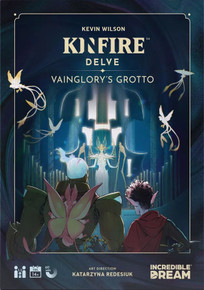
Kinfire Council
Kinfire Council
Kinfire Council is set in Din’Lux, a city guarded by the Beacon and shaped by competing leaders. Players act as Seekers working to influence those leaders across the council. Turns revolve around hand management and strategic card play. Every action is tied to timing and positioning rather than luck, and cards drive both abilities and interaction.
Each council seat represents a different path to points and power. Leaders offer asymmetric strengths, so approaches differ depending on who you support. As decrees and agendas change, strategies must adapt rather than follow a scripted plan. Replay value comes from variable council combinations, shifting objectives and evolving round dynamics.
Interaction is direct and persistent. Players react to each other’s moves, compete for limited influence spots and adjust their tactics as the political landscape develops. Scoring remains open until late in the game, so early plays don’t lock in the outcome and late turns stay meaningful.
The components reinforce clarity and theme, while the mechanics carry the depth. Icon prompts and card effects help new players learn quickly, but experienced groups can dig into nuanced combinations and counterplay. It fits players who prefer layered strategy, adaptive goals and systems that reward planning over randomness.
Kinfire Council
Kinfire Council is set in Din’Lux, a city guarded by the Beacon and shaped by competing leaders. Players act as Seekers working to influence those leaders across the council. Turns revolve around hand management and strategic card play. Every action is tied to timing and positioning rather than luck, and cards drive both abilities and interaction.
Each council seat represents a different path to points and power. Leaders offer asymmetric strengths, so approaches differ depending on who you support. As decrees and agendas change, strategies must adapt rather than follow a scripted plan. Replay value comes from variable council combinations, shifting objectives and evolving round dynamics.
Interaction is direct and persistent. Players react to each other’s moves, compete for limited influence spots and adjust their tactics as the political landscape develops. Scoring remains open until late in the game, so early plays don’t lock in the outcome and late turns stay meaningful.
The components reinforce clarity and theme, while the mechanics carry the depth. Icon prompts and card effects help new players learn quickly, but experienced groups can dig into nuanced combinations and counterplay. It fits players who prefer layered strategy, adaptive goals and systems that reward planning over randomness.




